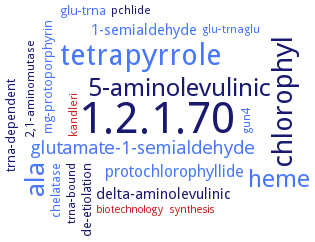1.2.1.70: glutamyl-tRNA reductase
This is an abbreviated version!
For detailed information about glutamyl-tRNA reductase, go to the full flat file.

Word Map on EC 1.2.1.70 
-
1.2.1.70
-
tetrapyrrole
-
chlorophyl
-
ala
-
5-aminolevulinic
-
heme
-
glutamate-1-semialdehyde
-
protochlorophyllide
-
delta-aminolevulinic
-
1-semialdehyde
-
de-etiolation
-
chelatase
-
mg-protoporphyrin
-
glu-trna
-
trna-dependent
-
kandleri
-
pchlide
-
gun4
-
glu-trnaglu
-
trna-bound
-
2,1-aminomutase
-
biotechnology
-
synthesis
- 1.2.1.70
- tetrapyrrole
-
chlorophyl
- ala
-
5-aminolevulinic
- heme
- glutamate-1-semialdehyde
- protochlorophyllide
-
delta-aminolevulinic
- 1-semialdehyde
-
de-etiolation
- chelatase
- mg-protoporphyrin
- glu-trna
-
trna-dependent
- kandleri
-
pchlide
- gun4
- glu-trnaglu
-
trna-bound
-
2,1-aminomutase
- biotechnology
- synthesis
Reaction
Synonyms
AtHEMA1, EC 2.7.2.13, GluRS, glutamate tRNA reductase, glutamate-specific tRNA reductase, glutamyl transfer RNA reductase, glutamyl-tRNA reductase, GluTR, GluTR1, GTR, GtrR, hemA, HEMA1, HEMA2, reductase, glutamyl-transfer ribonucleate, ZjGluTR
ECTree
Advanced search results
Systematic Name
Systematic Name on EC 1.2.1.70 - glutamyl-tRNA reductase
Please wait a moment until all data is loaded. This message will disappear when all data is loaded.
L-glutamate-semialdehyde:NADP+ oxidoreductase (L-glutamyl-tRNAGlu-forming)
This enzyme forms part of the pathway for the biosynthesis of 5-aminolevulinate from glutamate, known as the C5 pathway. The route shown in the diagram is used in most eubacteria, and in all archaebacteria, algae and plants. However, in the alpha-proteobacteria, EC 2.3.1.37, 5-aminolevulinate synthase, is used in an alternative route to produce the product 5-aminolevulinate from succinyl-CoA and glycine. This route is found in the mitochondria of fungi and animals, organelles that are considered to be derived from an endosymbiotic alpha-proteobacterium. Although higher plants do not possess EC 2.3.1.37, the protistan Euglena gracilis possesses both the C5 pathway and EC 2.3.1.37.


 results (
results ( results (
results ( top
top





